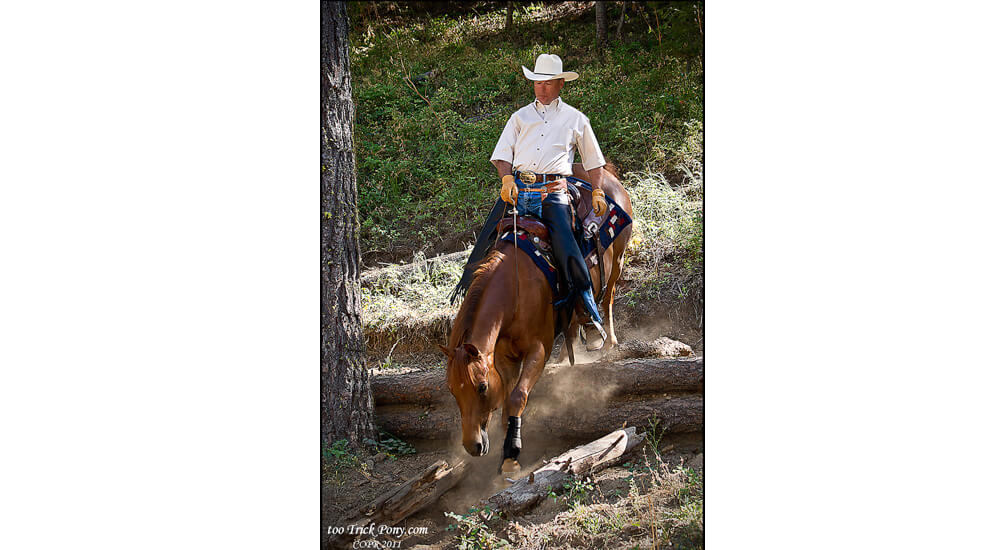A Unique Approach to Mastering a Challenging Discipline
by Nicole Zanakis
On a sunny, cool morning in Washington State, I’m watching riders navigate their horses over trail obstacles. Standing next to me is the trainer, Mark Bolender. He’s a three-time national Grand Champion in the sport, and he’s pointing out the nuances a judge might look for during a competition.
He nods at a brisk and confident attempt by a chestnut mare and says, “Now that’s close to perfection.” Mark ought to know what perfection is because he also judges Mountain Trail competitions. But he didn’t achieve perfection overnight. “Getting to the top in the sport of Mountain Trail really requires focusing on one trail obstacle at a time,” Mark says. “Learn how to navigate it perfectly and then move on to achieve the same on the next obstacle. It’s the only way to approach it.”
In the past five years Mark has concentrated most of his energy on building and promoting the new discipline of Mountain Trail. He spends hours on horse training, teaching clinics, giving demonstrations, writing about the sport and helping others build Extreme Trail and Mountain Trail courses across the USA and Europe.
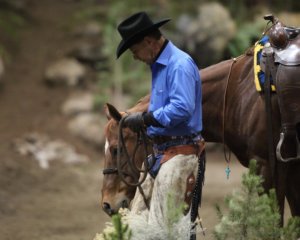
Never too far from Mark’s voice is Lee Sampson, his manager. Lee says that Mark’s dedication to the sport is total and unrelenting. “His schedule is so hectic,” Lee says, “but he’d never choose to do anything else.”
Lee helps Mark manage the activities of Bolender Horse Park (BHP) in Silver Creek, Washington. BHP is gaining the reputation of the premier place to learn and train, where clients from all over the globe can stay for just a day or many weeks. In my short stay at the Park, I can already sense that Mountain Trail is growing rapidly. A bewildering number of people are coming and going for clinics, lessons, training, or riding vacations. At times BHP has the air of a major tourist destination for horse enthusiasts.
BHP clients can experience the magic and thrill of Mountain Trail because Mark’s“Extreme Mountain Trail” course is one-of-a-kind. It has numerous breath-taking obstacles that you can simply attempt or even master. All aspects of the course have varying degrees of difficulty to meet and challenge both the beginner and advanced horse and rider. Trails also traverse the adjacent scenic woods for anybody who simply wants to enjoy a quiet trail ride.
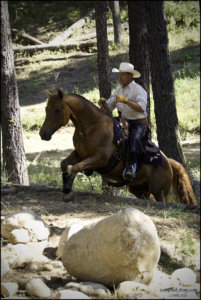
I have studied Mark’s special technique for horse training, called Unique Horsemanship, and I have also spent a few days watching him interact with riders and horses. It’s quite apparent to me that his success is the result of critically studying the horse’s mind in order to understand how it thinks – which influences his approach to training. Unique Horsemanship breaks down the horse’s instincts into human terms that enable us to effectively train it for Mountain Trail. In short, Mark teaches that there are four principles governing a horse’s world. These principles are based on the premise that in order to train a horse you must enter its world so it can cooperate in ours. This means that you must know and understand a horse’s motivations and what it expects from you. Mark says with steadfast certitude, “It boils down to not who is boss, but who is worthy of leadership.”
Mark teaches his students and clients that a horse’s expectations are determined by instinct. Yet he’s also quick to point out that a horse’s instinct is often what frustrates trainers the most, because it utterly controls the horse. And most of the time the trainer is unaware of what’s going on. “Understanding the horse’s instincts and expectations can be used as a training tool,” Mark says.
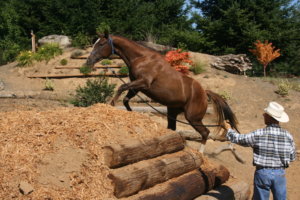
Mark demonstrates Unique Horsemanship to Mountain Trail devotees everywhere, and a large part of building the new discipline is providing lessons and clinics in America and abroad. He insists that training must first start with good, basic equitation so most clinics focus on the rider’s seat. “With a good seat and the rider being in proper balance, the horse is not distracted from naturally performing and navigating Mountain Trail obstacles,” he says.
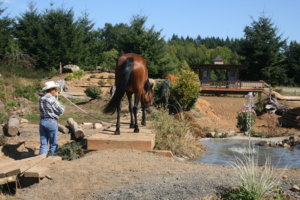
Mark emphasizes that the greatest challenge in training is building confidence in both horse and rider. Quite often horses that come to BHP for Mountain Trail training must be taught, and then allowed, to think on their own. Some horses are so trained to listen to the rider they no longer have the ability to think independently. That results in a horse that’s too frightened to make a decision about how to best navigate an obstacle. But with patience and allowing the horse to “think it through,” progress can be rapid.
Mark maintains that the discipline of Mountain Trail “Allows a horse to be a horse, and brings out all of their majestic beauty.” This leads to a trust and partnership between horse and rider, and such unity is the ultimate goal of Mountain Trail training. Mark enjoys navigating trail obstacles bridle-less because it demonstrates this ultimate goal of trust and partnership. He says, “Overall, my main objective is to show the world how this new sport can bring so much joy to the horse and rider, and to those watching. The trust and partnership is never more apparent than when horse and rider are effectively navigating Mountain Trail obstacles. When there’s unity, it’s just magical to watch.”
Published in the November 2011 Issue

The Northwest Horse Source is an independently owned and operated print and online magazine for horse owners and enthusiasts of all breeds and disciplines in the Pacific Northwest. Our contemporary editorial columns are predominantly written by experts in the region, covering the care, training, keeping and enjoyment of horses, with an eye to the specific concerns in our region.





